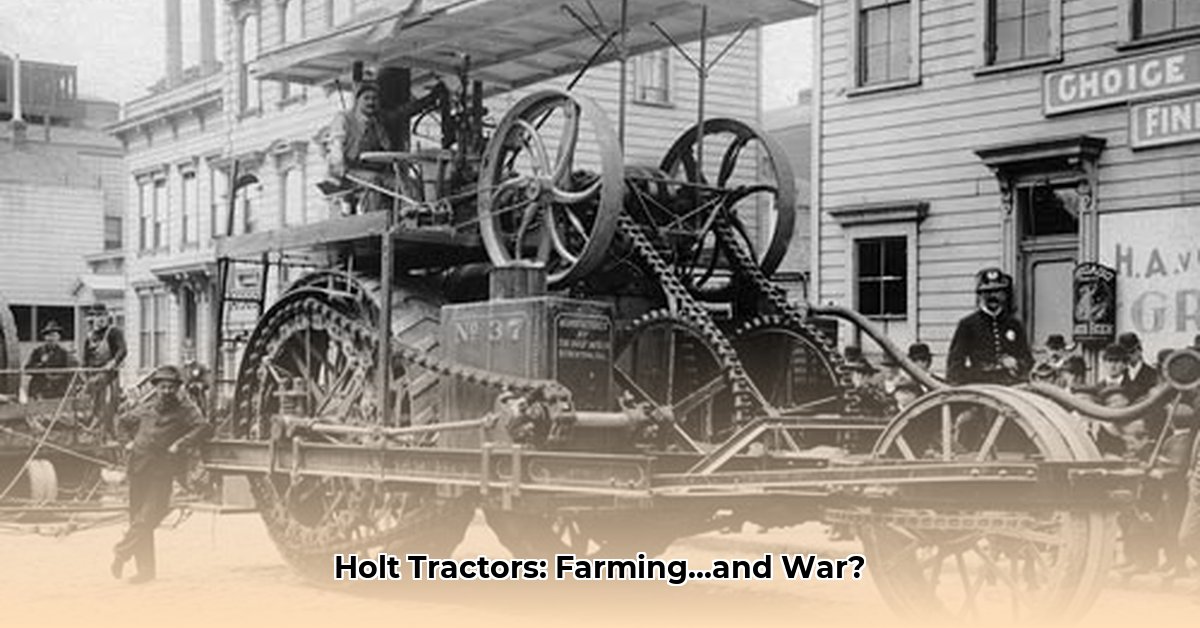
The roar of modern agricultural machinery often overshadows the rumble of its ancestors. Before the high-tech giants of today, there was the Holt tractor – a machine that didn't just plow fields; it revolutionized farming and unexpectedly reshaped warfare. This isn't simply a story about a machine; it's an epic of ingenuity, adaptation, and the profound impact of a single invention. For more on early tractor brands, see this helpful resource: Old Tractor Brands.
The Dawn of Tracked Power: Conquering Unforgiving Terrain
Imagine the challenges of farming in early 20th-century California. Rough terrain, heavy loads, and limited technology hampered agricultural progress. Benjamin Holt saw this struggle firsthand. Recognizing the limitations of wheeled vehicles, he conceived of a radical solution: a tractor propelled by continuous tracks instead of wheels. This wasn't just an incremental improvement; it was a paradigm shift, laying the foundation for modern tracked vehicles. His early steam-powered behemoths, while far from sleek, possessed an undeniable power and tenacity that transformed the agricultural landscape. They could traverse terrains that would have swallowed wheeled vehicles whole, effectively doubling – if not tripling - the usable farmland. Was this the single most important advancement in early 20th-century agricultural technology? The evidence overwhelmingly suggests yes.
The Holt 75, 120, and 60: Refining the Revolution
Holt's initial designs, while groundbreaking, weren't without their quirks. Steering was cumbersome, engines were inefficient, and the sheer size of these machines presented logistical challenges. Think of driving a powerful, temperamental beast – impressive in its might, but demanding in its needs. Yet, their impact was undeniable. The Holt 75, 120, and 60 models represented a progression of improvements, each iteration building upon the successes and addressing the shortcomings of its predecessor. The numbers likely signified horsepower or some other key performance metric. However, it was the continuous track system—the heart of the Holt design—that provided unmatched traction and stability, allowing them to conquer previously inaccessible land. This relentless pursuit of improvement is a hallmark of Holt's legacy.
| Model | Approximate Horsepower | Approximate Weight | Key Features |
|---|---|---|---|
| 75 | 75 | Very Heavy | The foundational design, establishing the tracked tractor standard. |
| 120 | 120 | Even Heavier | A significant power boost, capable of handling larger loads. |
| 60 | 60 | Lighter | More maneuverable, arguably more suitable for smaller farms. |
From Fields to Frontlines: An Unexpected Battlefield Debut
The influence of Holt tractors extended far beyond the farm. Their unmatched power and traction proved invaluable in massive infrastructure projects, such as the construction of the Los Angeles Aqueduct. However, their most surprising impact came on the battlefields of World War I. Adapted for military use, these agricultural workhorses became essential tools of war, hauling artillery and supplies across treacherous terrain. This unexpected application not only highlighted their versatility but also laid the groundwork for tank development, forever intertwining their legacy with military history. "The adaptation of the Holt tractor to warfare was a pivotal moment, showcasing its inherent robustness and adaptability," states Dr. Eleanor Vance, Professor of Military History at the University of California, Berkeley. This crucial transition from farmland to frontline is a testament to the innovative design of the Holt tractor.
A Legacy Forged in Steel and Innovation
The story of Holt tractors is more than just the history of machines; it's a narrative of human ingenuity and the transformative power of innovation. "Holt's legacy transcends mere agricultural advancement; it embodies the spirit of relentless improvement and adaptation," comments Dr. David Miller, curator of agricultural technology at the Smithsonian National Museum of American History. Their impact on agriculture is undeniable, but their contribution to engineering and military history is equally significant. They weren't just tools; they were catalysts for change, profoundly shaping both landscapes and warfare. The Holt tractor's legacy continues to roll forward, literally and figuratively. The company's merger with C.L. Best Gas Traction Company to form Caterpillar further cemented this enduring impact on the world.
Key Takeaways:
- Revolutionary Track System: The continuous track system revolutionized traction and maneuverability in challenging terrains.
- From Steam to Gasoline: The transition to gasoline power marked a significant leap in efficiency and operational convenience.
- Unexpected Military Application: Their adaptation to warfare accelerated technological advancements and directly influenced tank development.
The enduring impact of Holt tractors is a testament to the transformative power of even seemingly simple innovations. Their legacy continues to inspire and shape future advancements in agricultural and engineering technologies.